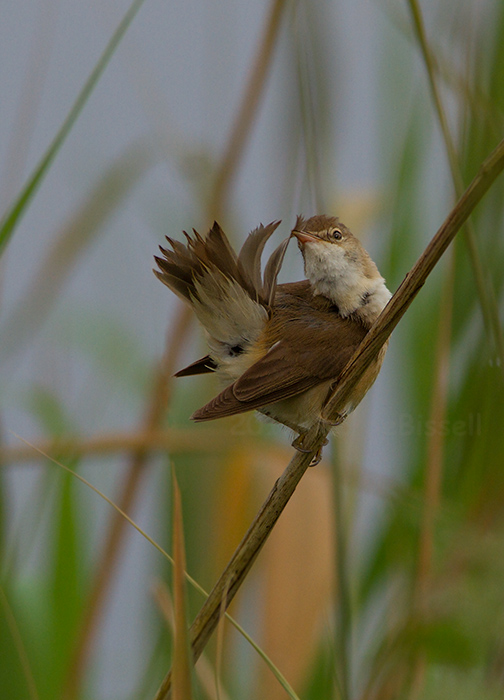
Reed Warbler, Longham Lakes, 29/5/17 (Lorne Bissell)
29th May
I didn’t wander far this morning but a visiting birder went round and didn’t mention anything out of the ordinary. Young Reed Warblers are being fed and Great Crested Grebes are displaying, plenty of Hirundines about and a Grey Heron now sits in the Great White Egrets’ tree…(Lorne Bissell),
26th May
Went round the south lake this morning very quite again. 15 Reed Warbler singing, 1 Blackcap, 2 Whitethroat and 5 Reed Bunting, 2 Chiffchaff also singing. 13 Greylag Geese settled on the water before flying off east. Carp spawning in South Lake along the edge of the causeway from the slipway up to the north west corner (Martin Wood.)
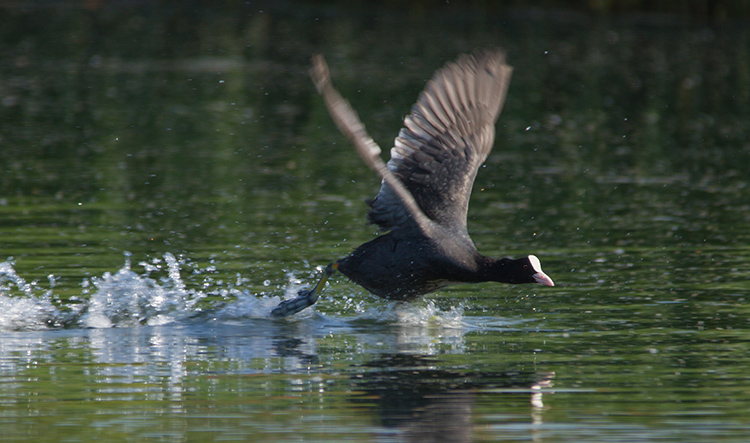
Coot, Longham Lakes, 25/05/2017 (Lorne Bissell)
25th May
A gorgeous day to be around the lakes, and the site was full of activity. One interesting observation was of a Bank Vole, the first seen at Longham this year. Unfortunately it was in the talons of a Kestrel, so close that I could see the colour of the vole’s back, even as it was carried off. There is obviously a pair of Kestrels breeding nearby. Other observations included a singing Treecreeper in Emily’s Wood, plus a pair of Stock Doves and a Great Spotted Woodpecker there. Roger Peart had a Raven over at 6am. In the general area was a flock of 15-20 Starlings, mostly juveniles flying noisily about.
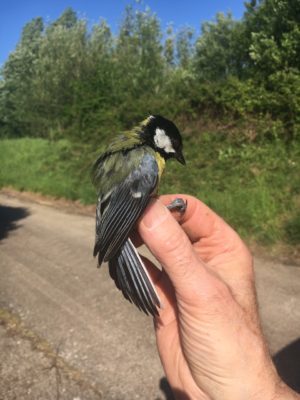
A long-lived Great Tit – 5 years, 260 days and counting!
Meanwhile, ringing this morning revealed Wren 1, Dunnock 2, Robin 2, Whitethroat 2, Great Tit 3, Bullfinch 1, Reed Bunting 1. There was more interesting re-traps: one each of Blackbird (ringed Sep 2015 as juvenile), Robin (ringed July 2015 and retrapped 2 days ago!), Cetti’s Warbler (ringed Oct 2015 age unknown) and Great Tit (ringed Sep 2011 as a first year bird). I am sure this is the oldest Longham Great Tit known to date – 5 years, 260days and counting!
24th May
The male Garganey was still around today (Dave and Pat Harris).
23rd May
During a ringing session at Longham this morning were 19 new birds and 5 re-traps. New birds were, 2 Dunnock, 3 Robin, 2 Song Thrush, 1 Blackbird, 3 Blackcap, 2 Chiffchaff, 3 Long-tailed Tits, 1 Blue Tit and 2 Chaffinch.
The re-traps were interesting: a) Robin ringed July 2015 as a juvenile ; b) Dunnock ringed in May 2012 as adult female ; c) three Chiffchaffs – one ringed March this year, one ringed April 2016 as adult and the other ringed September 2015 as a first year. Nice to have some oldies back again!
At about 6am there were 20+ Swifts high overhead (Roger Peart.)
21st May
Not much to report about very quiet round the lakes today with few Tufted Duck on north lake and a couple of Great Crested Grebe on south lake; also 19 Greylag Geese, these moved off to the Hampreston fields. 12 Reed Warbler singing between the causeway and round South Lake with 2 Whitethroats singing on near the north west corner and one near the south east corner of South Lake (Martin Wood).
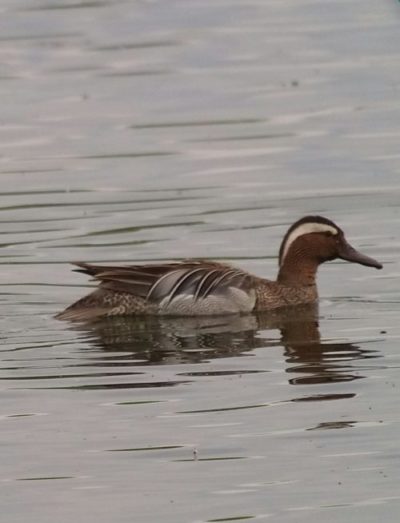
Garganey, Longham Lakes, 18/05/17 (Martin Wood).
18th May
A fine pair of Garganey turned up on Longham Lakes this evening (Martin Wood). The Bonaparte’s Gull is still around (George Green). Otherwise quiet.
16th May
After failing to see it on my last 4 visits, despite thorough searching, I was surprised to find the Bonaparte’s Gull back at Longham Lakes this pm showing very well perched on the floating tyres close to the shore of the North Lake. The black head is progressing nicely. Otherwise nothing to report (George Green).
15th May
A Red Kite flew over today, the first of the year (Rose Kempshall.)
Meanwhile, Darran Jones has created a Flickr album of his favourite Longham Lakes pictures. See here https://www.flickr.com/photos/101862661@N04/sets/72157680061752184
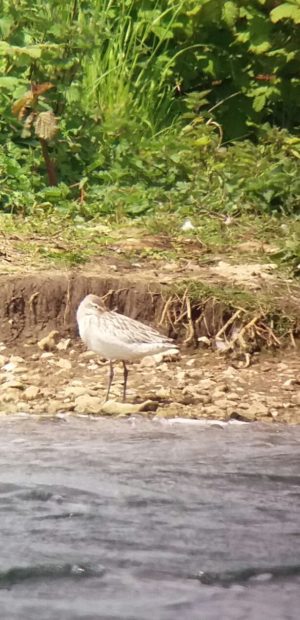
Bar-tailed Godwit, Longham Lakes, 13/05/17 (Martin Wood)
13th May
Yet another great bird was at Longham today. Martin Wood found this Bar-tailed Godwit (presumably a female owing to the lack of orange colour) on the main island in the south lake today, and fortunately it stuck around. The only previous record was on May 1st 2007, see here
so it’s been ten years! Among the other birds reported were Cuckoo, Peregrine, Hobby and at least 80 Swifts (Robin Trundle, Trevor Thorpe, Bob Moore.)
11th May
Longham has never been quiet for long this spring, and today’s new treat was a pair of Garganey that showed on the south end of the Big Lake during the morning (Darren Hughes). Still present at 9.30am but then flew east towards River Stour and disappeared from sight. Common Tern and Common Sandpiper also present (George Green). Later in the day, the Bonaparte’s Gull was reported (Dorset Bird Club).
8th May
The Bonaparte’s Gull was seen again today.
7th May
3 beautiful Black Terns appeared at Longham this morning and remained on-site during the whole day, delighting many of the locals and continuing the astonishing run of good records here. They provided an excellent supporting cast to the Bonaparte’s Gull, which has now been here for 12 days. Other good birds included a singing Cuckoo.
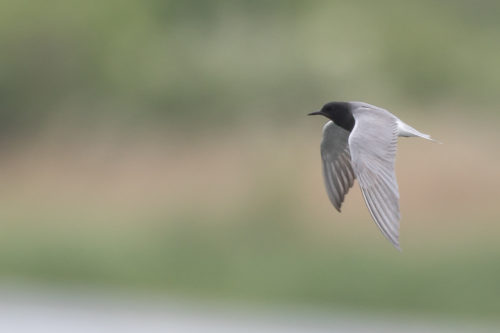
Black Tern, Longham Lakes 7/5/2017 (Darran Jones)
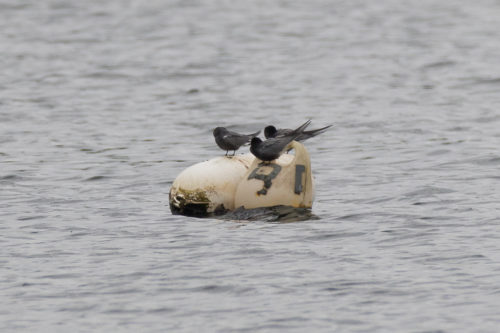
Black Terns, Longham Lakes 7/5/2017 (Darran Jones)
6th May
This morning I had my 2nd site record of a Marsh Harrier. A female type bird which arrived from the south, circled over the South Lake and then headed east (George Green). The Bonaparte’s Gull was there between 2:00 and 4:00. Also 3 Pochard, 3 Hobby and a Garden Warbler (David Taylor) [first of the year]. There was also a Cuckoo calling in the afternoon (Darran Jones).
5th May
Another new bird for the year appeared today, when a Little Ringed Plover briefly flew over the South Lake and then left east towards Christchurch (Matthew Bell). This afternoon there were lots of Swifts hawking over the Causeway. whizzing past at eye level and close at times. Then high up, I heard them screaming, as they do, so I looked up expecting a Hobby, but there were at least 200 birds, and the best way I can explain it was they formed a large dark mass like when you see a large herring ball on the documentary programmes. All the birds were travelling in a westward direction. On the south side of the island two Shelduck were asleep, but the best bird of the afternoon was a wonderful Osprey that came in from the southeast over south lake. It was harassed by the gulls so turned drifted over Samuels Wood and looked like it was following the river going south southeast (Martin Wood.)
4th May
This morning at Longham Lakes, 14 singing Reed Warblers, 5 singing Cetti’s Warblers, c40 Swift, 1 Common Sandpiper and 1 Cuckoo calling (Trevor Thorpe.) The Bonaparte’s Gull was showing very well on the North Lake this evening c7pm. For the last 2 possibly 3 days it seems to have been absent during the day but present in the evening. Presumably it wandered to Hengistbury yesterday. It will be interesting if this pattern is repeated in future days. It is moulting rapidly and it will not be long before it has a black head (George Green.)
3rd May
The Bonaparte’s Gull was absent for most of the day but reappeared in the evening (Nick Whitehouse.)
2nd May
The Bonaparte’s Gull showed well again (Caroline Herbert.)
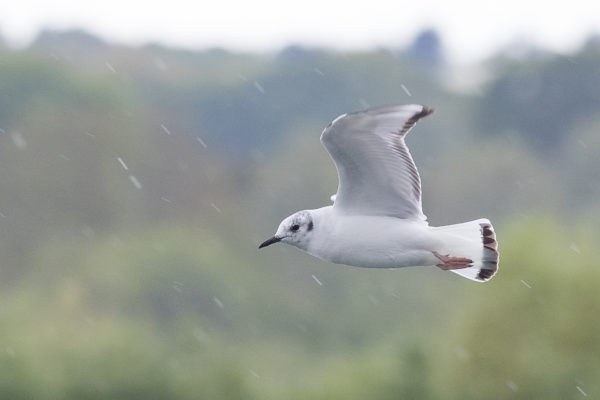
Bonaparte’s Gull, Longham Lakes, 1/5/2017 (Darran Jones)
1st May
Longham was absolutely swarming with Reed Warblers and Reed Buntings. I must have counted at least 17 Reed Warblers and easily saw over 20 Buntings as I walked the lakes for a couple of hours. I heard my first Cuckoo of the year. Caught my first Pheasant in the back fields and also saw my first Shelduck on site since I’ve been going to Longham. The Bonaparte’s Gull was showing exceptionally well, but there was no sign of the Black Terns that had been reported the previous day. I counted 8 Cetti’s Warblers as well [that’s a record!], although I’ve seen no Little Grebes whatsoever (Darran Jones.) Also 20 Swifts (Steve F Smith).
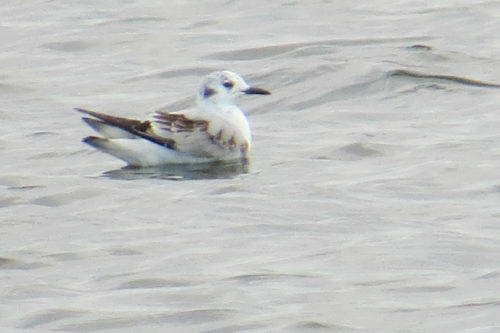
Bonaparte’s Gull, Longham Lakes 29/4/17 (Roger Peart)
30th April
Two Black Terns moved through during the day (Birdguides). Otherwise the 1st-Summer Bonaparte’s Gull is still around, along with an excellent general variety. Cuckoo was heard again (George Green).
29th April
There was a SERIN around the Study centre in the morning, heard just a few times and not seen (Darren Hughes). This is the third new species for Longham in less than a week! Bearing in mind that the Bonaparte’s Gull continues to delight visitors and you could say that this site is in dreamland. It was also a day for more usual fare, with the first Cuckoos of the year appearing, first a male singing early morning (Dominic Couzens) and then a brown female flying over the lake (Lorne Bissell).
Obviously, many birds are settling into breeding territories. To this end, it was interesting to see a pair of Shelduck on the south side of the site, near the settling pools south of the River Stour – could they breed in a tree hole nearby? At the same place there was a pair of Mistle Thrushes with well-grown young, fledged and almost independent. This is the first confirmed breeding record for the site. There was an Egyptian Goose on the main island in the South Lake in the evening, and 3 Common Sandpipers around.
28th April
Another amazing day at Longham Lakes! The Red-rumped Swallow was not seen today, but instead the first Osprey of the year appeared a couple of times mid-morning (Trevor Thorpe). Meanwhile, there was some serious Bonaparte’s Gull worship going on, as the photos here show.
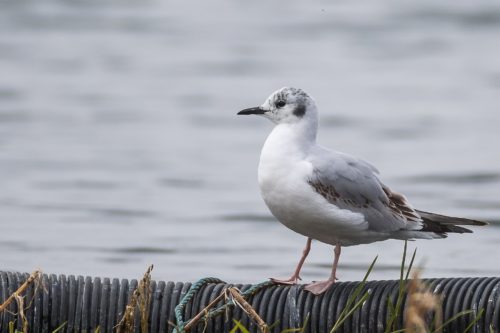
Bonaparte’s Gull (1st-summer), Longham Lakes 28/4/217 (Darran Jones)
Compared with Black-headed Gull look out for the black bill and bubble-gum coloured legs of Bonaparte’s.
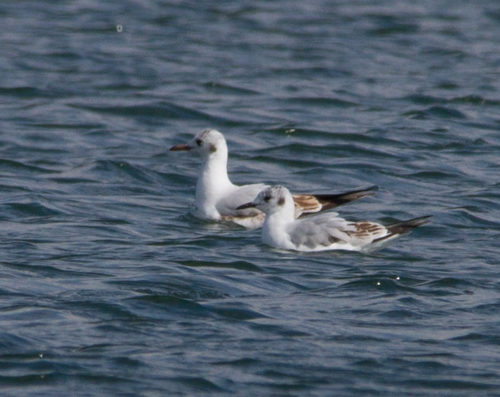
Bonaparte’s and Black-headed Gulls together, Longham Lakes, 28/4/2017 (Lorne Bissell).
Note that Bonaparte’s Gull (right, closer) is slightly smaller and more delicate than Black-headed, and also slightly darker grey on the mantle (although this is very subtle on this bird). The 1st-summer Black-headed can be seen to have an orange bill.
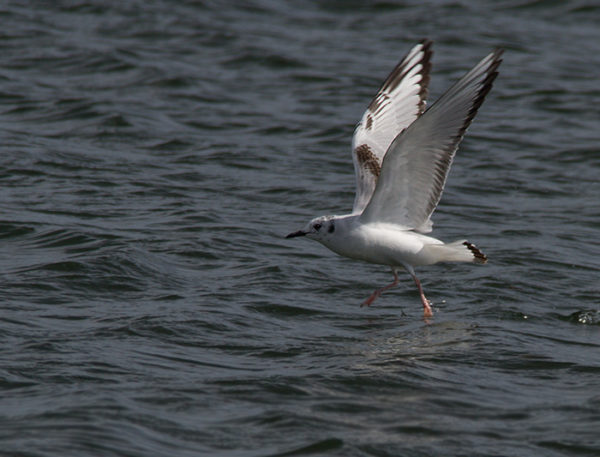
Bonaparte’s Gull, Longham Lakes 28/4/2017 (Lorne Bissell).
The above photo shows the distinctive underwing. In particular, the inside of the wingtip on the underwing is entirely pale, where in Black-headed Gull there is a dark band just behind the wing-tip. Incidentally, the very boldly marked black V on the upperwing is quite distinct from the bird at nearby Blashford Lakes.
In other news, there was a Great Spotted Woodpecker on site, which you can see next to the big white bird that’s been here for ages!
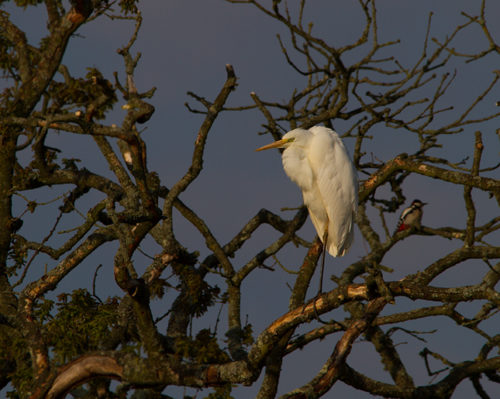
Great Egret, Longham Lakes 28/4/2017 (Lorne Bissell).
27th April
Unless your local patch is Spurn Head or Minsmere, you aren’t meant to get days like Longham produced today. For one glorious hour this evening, the first-summer Bonaparte’s Gull was swimming on Longham Reservoir North, while a RED-RUMPED SWALLOW, new for the site, was hawking insects over the Causeway. One bird, the swallow, is an overshoot from southern Europe, and the gull is a native of North America. These birds were on a small wetland in Dorset. Birding does this sometimes. The long-staying Great Egret was also around this morning – three rare birds at once!
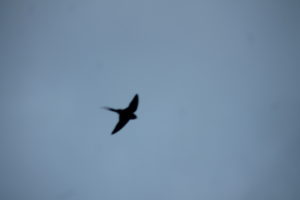
Poor record shot of Red-rumped Swallow, Longham Lakes, 27/4/2017
For most of the day, my main excitement was actually in the morning when, on a walk along the Stour on the South Side (unfortunately out of bounds to the public) I heard a Grasshopper Warbler singing, only the second record for Longham. In the same place Cetti’s, Reed and Sedge Warblers were also singing in a glorious patch of reedy, overgrown marsh. With Blackcap, Whitethroat and Chiffchaff in earshot, this was a major delight in itself. There were also 2 Bullfinches and a Treecreeper in Emily’s Wood, while a pair of Mistle Thrushes, quite scarce here, were feeding next to Ringwood Road south of Longham Bridge, inside the South-west Water holding. What with seeing a male Blackcap displaying to its mate (ruffling its feathers and chasing), and listening to such delights as the gentle cooing of a Stock Dove as a Hobby dashes past, this is great spring birding in its own right. There were also 2 Shelduck on the island and Mediterranean Gull flying over.
Then came a tweet about the Red-rumped Swallow (thanks, Martin) and the evening was madness. Here’s to patch birding!
26th April
This lunchtime and afternoon there is a 1st-summer BONAPARTE’S GULL on Longham Lakes, commuting between the North Lake and the NW part of the South Lake, found by George Green. It might be the bird from Blashford. It’s a first for the site.
If you’re visiting, please don’t use the Study Centre car park unless you have a Longham Birders permit.
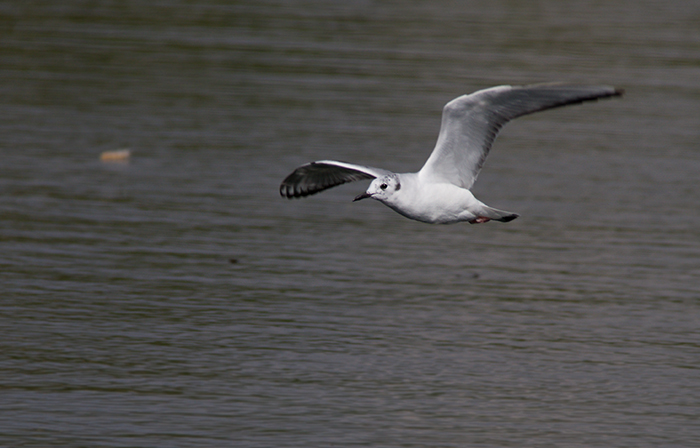
Bonaparte’s Gull, Longham Lakes, 26/4/17 (Lorne Bissell)
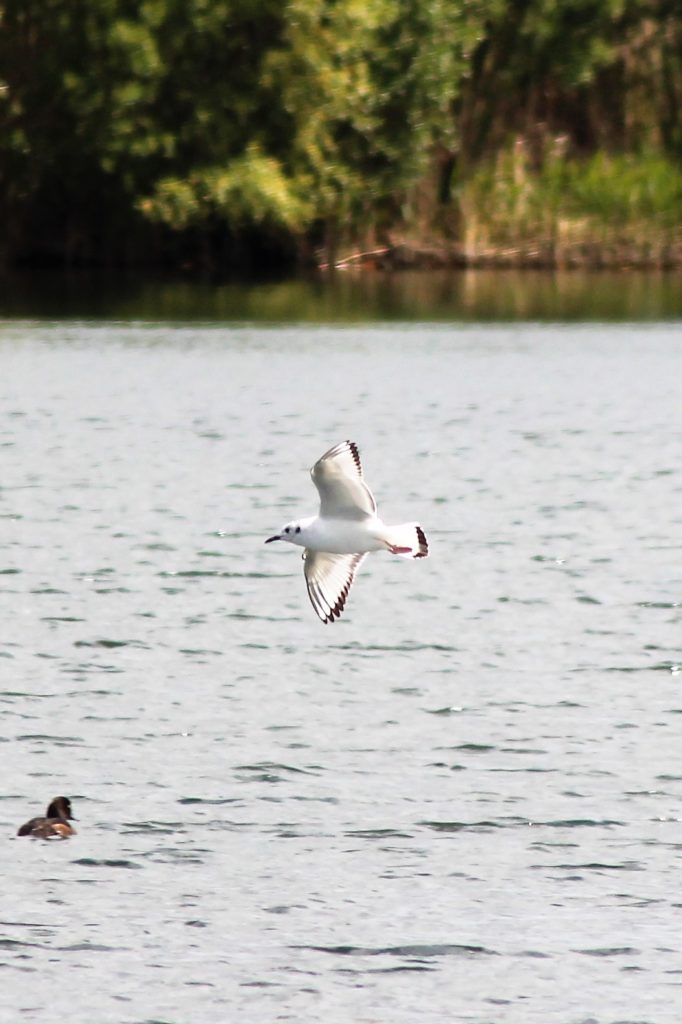
Bonaparte’s Gull (1st-summer), Longham Lakes, 26/4/2017 (Dominic Couzens)
There were lots of Swifts and all three Hirundines about, which attracted the first Hobby of the year (per Martin Wood).
25th April
This morning was cold but glorious. I saw a Grey Heron in between the 2 lakes and after quite some time it flew to a central perch in North lake. Saw 2 pairs of Mallards on North lake with clutches ducklings one had 4 and the other pair had 7. Saw a Pied Wagtail near North lake, a male Greenfinch and a Goldfinch in the Thicket. The whole time I was treated to aerial displays from many Swifts (Lesley Wilkes.)
23rd April
Last night’s flurry of migrants has disappeared but a Dunlin has appeared on the island in Longham Reservoir South (Martin Wood). A Whimbrel flew over.
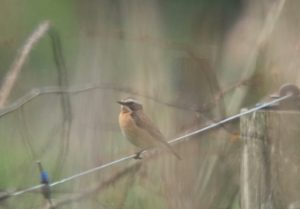
Whinchat, Longham Lakes 22/4/2017 (Martin Wood)
22nd April
By Longham standards, especially by its spring standards, today turned out to be good for migrants. In the morning, a Wheatear flew alongside the south lake, close to where the site’s first Sedge Warbler of the spring was singing. Meanwhile, Swifts were moving in quantity, with good numbers of Swallows and one each of House Martin and Sand Martin. Then, at lunchtime, Martin Wood found a glorious male Whinchat on Hampreston Fields – this is a rare spring migrant here. In the evening, a Wheatear was around the east end of the Causeway, near the Study Centre, while another was in the Horse Paddocks along Green Lane, close to the main road. There was also a flock of Pied Wagtails here, about 20 in all, together with a glorious male Yellow Wagtail, these days another quite scarce migrant. All this time at least 2, perhaps more Common Sandpipers were around the site. Other interesting birds included 3 Shovelers, 2 Shelduck and 3 Egyptian Geese, while there are still plenty of Gadwalls around. Some of the Mallards have broods of ducklings. A Linnet was by the south pumping station and a Goldcrest was singing along Green Lane (Dominic Couzens, George Green, Martin Wood).
On a personal note, I saw or heard 62 species on site today, close to the day-record of 67. I missed Blue Tit, too (Dominic Couzens)
20th April
There were 2 Egyptian Geese on Hampreston Fields this lunchtime, while Mallards on-site are in mass-production mode, with broods of 8 and 9 ducklings about. Other counts included 8 Great Crested Grebes and 2 Lesser Black-backed Gulls. Migrants are still only trickling in, although at least 3 Reed Warblers are in and singing, while 10 Swallows and some Swifts passed by. At least 7 male Reed Buntings are about (Trevor Wilkinson).
16th April
Whitethroat, Blackcap, 3 Redshank and 1 Common Sandpiper. Last two on North side of large lake. Also my first Orange Tip and a Muntjac Deer in the copse by the river (Ron Poulter). [The Muntjac is the first site record for more than 10 years, although there have been tracks].
15th April
A very quick look in the afternoon today revealed nothing much on the lake, but there were a pair of Linnets by the Pumping Station on the east side of the South Lake. Also 8 Gadwall, 3 Shelduck and a Lapwing, with Reed Warblers and a Whitethroat in(Dominic Couzens).
14th April
Had a wonderful morning at Longham Lakes today from 09.00 -11.40hrs. A Cetti’s Warbler was blasting out its short song just south of the Study Centre, while nearby I heard the wonderful song of a Willow Warbler. Stopping off at the slipway to look across to the large island I noticed the Common Sandpiper on the little jetty, two Lesser Black-backed Gulls, a Lapwing and Tufted ducks on the east side of the island. I stopped and scanned up and down the oak trees at Samuel’s Wood with binoculars, as I have done on every visit for the past four years with the hope of seeing a Treecreeper or – the holy grail of Samuel’s Wood – a Nuthatch. I was very surprised to find working a large limb of an Oak at the back of the wood a wonderful Nuthatch!
Eventually I arrived at the small ponds at the south end of the lake were I found the Great White Egret working the edge of the reeds, before flying up in to the large Oak at the back of the ponds. Working along the reeds I was surprised to find a fresh water terrapin out up on the bank warming up in the sun (Martin Wood).
In the afternoon, there were Swallows, House Martins and 2 Swifts. The latter are the earliest ever recorded here, by 1 day! (Dominic Couzens).
13th April
A light scattering of migrants, including Sand Martin, Swallow, Reed Warbler and Common Sandpiper. One Great Egret remained [this was the last record of the long-stayers]. (Dave and Pat Harris).
12th April
Had a quick hours walk round the North lake. Couple of Swallows, 8 Sand Martin , also the Common Sandpiper on the large island in South Lake. Also 3 Cetti’s Warblers calling/ singing (Martin Wood).
11th April
Great White Egret still present roosting in tree just south of southern shore of South Lake. Also a Common Sandpiper on the shore of the North Lake (George Green.)
9th April
It was a lovely morning though walking down Green Lane, with Blackcap singing, Collared Doves cooing and Goldfinches sinhing. Out on North Lake the usual fare of Tufted Duck, Coots and Great Crested Grebes with 2 Mediterranean Gulls over and a Swallow. At least 5 calling Cetti’s Warblers round the lake. On the large island in south lake there was one Black-tailed Godwit and one Shelduck (Martin Wood).
8th April
Had a really great walk around the lakes this morning. What a fabulous day. The Great White Egret still there. Plenty of Cetti’s Warblers, Wrens, Blackcaps and Chiffchaffs, all singing their hearts out and a good representation of Mediterranean Gulls (Robin Trundle.)
7th April
A Swallow over the south lake. A few Gadwall are still about. Looking forward to a flood of migrants when the weather turns (Dominic Couzens). Also 1 male Blackcap, but also a (fairly quietly) singing Reed Warbler on the northern lakeside. 2 Great Egrets flew over the causeway from the fields by the river (Carl Wilcox).
5th April
A 20-minute look on the north of the site produced a bonus in the form of 2 Linnets feeding in the big field (with huge oak tree) to the north of the Study Centre. These finches are not common here (Dominic Couzens).
4th April
The seemingly ‘resident’ Great White Egret was still present on Hampreston Fields. Otherwise nothing to report (George Green.)
2nd April
Went to Longham again today. Chiffchaffs and Chaffinches were singing away as we walked down Green Lane, while out on North Lake it looked like most of the Tufted Ducks were on the water with a few Mediterranean Gulls and Great Crested Grebes. A Cetti’s Warbler was calling on the western side of the lake, while scanning over the fields I found the Great White Egret down on the river and 2 Shelduck in the pool in the shire horse field. As we returned we found a Great Spotted Woodpecker, but still no sign of those darn Bullfinches (Martin Wood.)
1st April
The site was pretty quiet early morning, with no obvious overhead migration except for a Meadow Pipit. However, it is clear that plenty of Chiffchaffs and Blackcaps are in, and a few Willow Warblers are passing through. Apart from that, a few wildfowl are hanging on (8 Shovelers today) and 2 Shelducks were on the island in the South Lake, a new species for the year. There were also 6 Snipe on the island, quite a good total.
The appearance of Mediterranean Gulls in large numbers at Longham is a strange and very seasonal phenomenon (mid-March to early April). It is also a daily ritual. Very few birds were on the lakes at 7.00am, but almost on 8.00am sharp, flocks began to appear from the south-west and gather in a large, noisy group (Dominic Couzens.)
